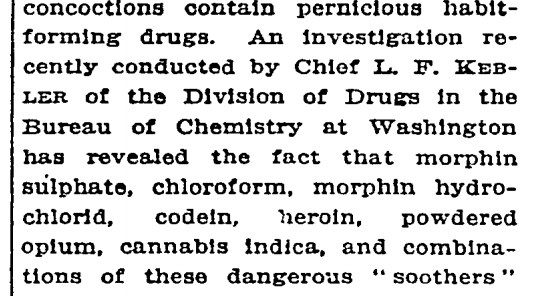Funtabulously Frivolous Friday Five 101
Just when you thought your brain could unwind on a Friday, you realise that it would rather be challenged with some good old fashioned medical trivia FFFF, introducing the Funtabulously Frivolous Friday Five 101
Question 1
What was the key ingredient in Mrs. Winslow’s Soothing Syrup?
Reveal the funtabulous answer
Morphine
To aide the stressed 19th-century mother, a series of “soothing syrups,” lozenges and powders were created, all which were carefully formulated to ensure they were safe for use by those most vulnerable members of the family [Reference]
In fact each 10mL vial was laced with up to 65mg of morphine…
The Narcotic based baby-sitter service was exposed in a New York Times article in 1910 which revealed evidence of the “systematic ‘doping’ of the delicate organisms of infant with these subtle and powerful drugs is practiced everywhere remorselessly or in desperate ignorance of it’s consequences” [Reference].
Question 2
So you’ve decided to go all out for the Smurf costume for that fancy dress party. How would you permanently turn your skin blue, and what is the term for this?
Reveal the funtabulous answer
Argyria
While more grey-silver than blue, some cases of Argyria can be dramatic.
This irreversible discolouration of the skin is a rare dermatological curiosity caused by the chronic ingestion of colloidal silver. [Case Report BMJ]
Although silver colloids and salts have been withdrawn and/or banned by some drug surveillance agencies, they continue to be freely sold and unregulated as food supplements and as ingredients in alternative medicines, thereby risking the emergence of new cases of silver poisoning. [Case Report]
Question 3
You know nothing Jon Snow!
Ygritte (Game of Thrones)
Reveal the funtabulous answer
John Snow (1813-1859) was a British physician, widely acclaimed as the “father of epidemiology”
Dr Snow pioneered an observational study on cholera epidemics in London between 1854-1857 and later published ‘On the Mode of Communication of Cholera’, a paper which managed to trace an outbreak of cholera to the Broad St pump in London.
It was the Lancet who effectively suggested he ‘knows nothing‘ as they failed to recognise this epidemiological achievement in his obituary, and their editorial at the time (1855) was not exactly supportive…
The Lancet wishes to correct, after an unduly prolonged period of reflection, an impression that it may have given in its obituary of Dr John Snow on June 26, 1858. The obituary briefly stated:
“Dr John Snow: This well-known physician died at noon, on the 16th instant, at his house in Sackville Street, from an attack of apoplexy. His researches on chloroform and other anaesthetics were appreciated by the profession.”
The journal accepts that some readers may wrongly have inferred that The Lancet failed to recognise Dr Snow’s remarkable achievements in the field of epidemiology and, in particular, his visionary work in deducing the mode of transmission of epidemic cholera. The Editor would also like to add that comments such as “In riding his hobby very hard, he has fallen down through a gully-hole and has never since been able to get out again” and “Has he any facts to show in proof? No!”, published in an Editorial on Dr Snow’s theories in 1855, were perhaps somewhat overly negative in tone.
The Lancet 2013
Question 4
Why are we interested in the blood of Horseshoe crabs?
Reveal the funtabulous answer
The LAL test
It’s not just an interest, it’s been an industry since the 1970’s. [Reference]
Limulus amebocyte lysate (LAL) is an clotting agent found in the aqueous extract of the horseshoe crab (Limulus polyphemus) blood.
The powder blue blood is extracted from the pericardium of live crabs, which are then returned to the water (attrition rate 3-10%…)
LAL reacts with bacterial endotoxin or lipopolysaccharide in the membrane of Gram negative bacteria. This reaction is the basis of the LAL test, used to detect and quantify bacterial endotoxins.
This FDA approved test ensures pharmaceuticals and medical equipment are endotoxin free!.
Question 5
What is “Seinfeld syncope” and when was it first reported?
Reveal the funtabulous answer
Laughter-induced syncope
This phenomenon was first reported in 1997 (Cox SV, Eisenhauer AC, Hreib K. “Seinfeld syncope“. Cathet Cardiovasc Diagn. 1997 Oct;42(2):242. PubMed PMID: 9328725).
It was described as “a combination of critical carotid stenosis and a prolonged Valsalva (from hysterical laughter while watching Seinfeld) resulting in repeated syncopal episodes.”
The rate of LIS has declined over the years as the quality of free to air comedy has exponentially declined
Further reading – Lancet case report
…and remember “laughter should be considered among numerous differentials for syncope” – Bragg, M. J. (2006)

FFFF
Funtabulously Frivolous Friday Five
Medical Registrar fascinated by the quirky history of medicine and those crazy microbes.





